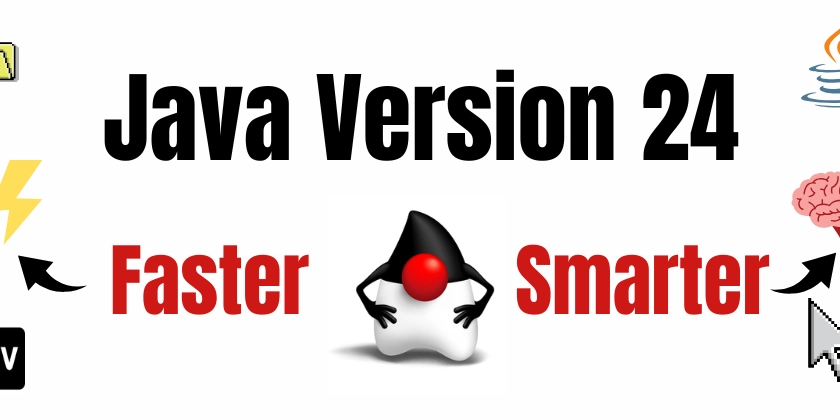Java Version 24 Performance Updates: Faster and Smarter!
Java is one of the most popular programming languages in the world, and it keeps getting better with every new version. Java 24 is here, and it brings some exciting performance updates that make it faster, more efficient, and easier to use. If you’re a developer, this is great news because your applications can now run smoother and handle more tasks without slowing down. Let’s take a closer look at what’s new in Java 24 and how it can help you write better code. Java’s Journey to Becoming Faster Java has always been known for its reliability, but in recent years, it has also become a leader in performance. Java 21 was a big step forward, but Java 22 and 23 made it even faster. Now, with Java 24, the language is reaching new heights. These improvements are thanks to the hard work of the OpenJDK community, a group of developers who are constantly working on projects to make Java better. Key Projects Behind Java 24’s Improvements Several projects are driving the performance upgrades in Java 24. These projects focus on different areas, like making code cleaner, improving memory management, and enabling better scalability. Here are some of the most important ones: Project Amber: Cleaner Code, Better Performance This project adds new features to the Java language to make code shorter and easier to read. While the main goal is to help developers write code faster, it also has a nice side effect: cleaner code often runs faster and uses fewer resources. Project Babylon: Smarter Code Analysis Babylon gives Java the ability to analyze and modify its own code. This opens up new possibilities for optimization, including using GPUs for heavy computations. This means Java can now handle tasks that require a lot of processing power much more efficiently. Project Loom: Lightweight Threads for Better Scalability Handling multiple tasks at the same time can be tricky, but Project Loom makes it easier. It introduces lightweight threads that allow developers to manage millions of tasks without the overhead of traditional threads. This makes applications more scalable and efficient. Project Valhalla: Better Handling of Data Types Valhalla aims to close the gap between primitive data types (like integers) and objects. By introducing value types, it allows developers to work with data in a way that’s both fast and flexible. This means better performance without sacrificing the benefits of object-oriented programming. Challenges in Performance Optimization Improving performance isn’t always easy. Developers often have to make tough choices, like balancing speed with memory usage or improving one part of the code at the expense of another. For example, making an application faster in some cases might make it slower in others. There are also technical challenges, like avoiding memory errors or dealing with complex code structures. These issues require careful planning and testing to get right. Top 5 Performance Improvements in Java 24 Java 24 introduces several major optimizations that make it stand out. Here are the top five: 1️⃣ Foreign Function and Memory API This feature allows Java to work more efficiently with native code and memory. It also supports SIMD (Single Instruction, Multiple Data) instructions, which let Java process multiple pieces of data at the same time. This is a big boost for tasks that require heavy computation. // 1. Foreign Function and Memory API import jdk.incubator.foreign.*; import java.lang.invoke.MethodHandle; import java.lang.invoke.MethodHandles; import java.lang.invoke.MethodType; public class ForeignMemoryExample { public static void main(String[] args) throws Throwable { // Allocate off-heap memory MemorySegment segment = MemorySegment.allocateNative(1024); try { MemoryAccess.setIntAtOffset(segment, 0, 42); // Write to memory int value = MemoryAccess.getIntAtOffset(segment, 0); // Read from memory System.out.println("Value: " + value); // Example with foreign function MethodHandle strlen = CLinker.systemCLinker().downcallHandle( CLinker.systemCLinker().lookup("strlen").get(), MethodType.methodType(long.class, MemoryAddress.class), FunctionDescriptor.of(CLinker.C_LONG, CLinker.C_POINTER) ); String str = "Hello, Foreign Memory!"; try (MemorySegment cString = CLinker.toCString(str)) { long length = (long) strlen.invokeExact(cString.address()); System.out.println("String length: " + length); } } finally { segment.close(); } } } 2️⃣ Improved Garbage Collector Java 24’s garbage collector has been redesigned to manage memory more effectively. It divides memory into sections and handles objects more precisely, reducing delays and making applications more responsive. // 2. Improved Garbage Collecto

Java is one of the most popular programming languages in the world, and it keeps getting better with every new version. Java 24 is here, and it brings some exciting performance updates that make it faster, more efficient, and easier to use. If you’re a developer, this is great news because your applications can now run smoother and handle more tasks without slowing down. Let’s take a closer look at what’s new in Java 24 and how it can help you write better code.
Java’s Journey to Becoming Faster
Java has always been known for its reliability, but in recent years, it has also become a leader in performance. Java 21 was a big step forward, but Java 22 and 23 made it even faster. Now, with Java 24, the language is reaching new heights. These improvements are thanks to the hard work of the OpenJDK community, a group of developers who are constantly working on projects to make Java better.
Key Projects Behind Java 24’s Improvements
Several projects are driving the performance upgrades in Java 24. These projects focus on different areas, like making code cleaner, improving memory management, and enabling better scalability. Here are some of the most important ones:
Project Amber: Cleaner Code, Better Performance
This project adds new features to the Java language to make code shorter and easier to read. While the main goal is to help developers write code faster, it also has a nice side effect: cleaner code often runs faster and uses fewer resources.Project Babylon: Smarter Code Analysis
Babylon gives Java the ability to analyze and modify its own code. This opens up new possibilities for optimization, including using GPUs for heavy computations. This means Java can now handle tasks that require a lot of processing power much more efficiently.Project Loom: Lightweight Threads for Better Scalability
Handling multiple tasks at the same time can be tricky, but Project Loom makes it easier. It introduces lightweight threads that allow developers to manage millions of tasks without the overhead of traditional threads. This makes applications more scalable and efficient.Project Valhalla: Better Handling of Data Types
Valhalla aims to close the gap between primitive data types (like integers) and objects. By introducing value types, it allows developers to work with data in a way that’s both fast and flexible. This means better performance without sacrificing the benefits of object-oriented programming.
Challenges in Performance Optimization
Improving performance isn’t always easy. Developers often have to make tough choices, like balancing speed with memory usage or improving one part of the code at the expense of another. For example, making an application faster in some cases might make it slower in others. There are also technical challenges, like avoiding memory errors or dealing with complex code structures. These issues require careful planning and testing to get right.
Top 5 Performance Improvements in Java 24
Java 24 introduces several major optimizations that make it stand out. Here are the top five:
1️⃣ Foreign Function and Memory API
This feature allows Java to work more efficiently with native code and memory. It also supports SIMD (Single Instruction, Multiple Data) instructions, which let Java process multiple pieces of data at the same time. This is a big boost for tasks that require heavy computation.
// 1. Foreign Function and Memory API
import jdk.incubator.foreign.*;
import java.lang.invoke.MethodHandle;
import java.lang.invoke.MethodHandles;
import java.lang.invoke.MethodType;
public class ForeignMemoryExample {
public static void main(String[] args) throws Throwable {
// Allocate off-heap memory
MemorySegment segment = MemorySegment.allocateNative(1024);
try {
MemoryAccess.setIntAtOffset(segment, 0, 42); // Write to memory
int value = MemoryAccess.getIntAtOffset(segment, 0); // Read from memory
System.out.println("Value: " + value);
// Example with foreign function
MethodHandle strlen = CLinker.systemCLinker().downcallHandle(
CLinker.systemCLinker().lookup("strlen").get(),
MethodType.methodType(long.class, MemoryAddress.class),
FunctionDescriptor.of(CLinker.C_LONG, CLinker.C_POINTER)
);
String str = "Hello, Foreign Memory!";
try (MemorySegment cString = CLinker.toCString(str)) {
long length = (long) strlen.invokeExact(cString.address());
System.out.println("String length: " + length);
}
} finally {
segment.close();
}
}
}
2️⃣ Improved Garbage Collector
Java 24’s garbage collector has been redesigned to manage memory more effectively. It divides memory into sections and handles objects more precisely, reducing delays and making applications more responsive.
// 2. Improved Garbage Collector
public class ImprovedGCExample {
public static void main(String[] args) {
System.out.println("Running with improved GC in Java 24.");
for (int i = 0; i < 1_000_000; i++) {
new String("Object " + i); // Generate garbage
}
System.gc(); // Trigger garbage collection
System.out.println("GC executed!");
}
}
3️⃣ Method Inlining and Loop Unrolling
The Java compiler now inlines methods (replacing method calls with the actual code) and unrolls loops (processing multiple iterations at once). These changes make code run faster by reducing unnecessary steps.
// 3. Method Inlining and Loop Unrolling
public class InliningExample {
public static void main(String[] args) {
int sum = 0;
for (int i = 0; i < 10_000; i++) {
sum += addNumbers(i, i + 1);
}
System.out.println("Sum: " + sum);
}
private static int addNumbers(int a, int b) {
return a + b;
}
}
4️⃣ Invariant Hoisting
This optimization moves calculations that don’t change inside loops to outside the loop. This reduces redundant work and speeds up execution.
// 4. Invariant Hoisting
public class InvariantHoistingExample {
public static void main(String[] args) {
int constant = 5;
int sum = 0;
for (int i = 0; i < 10_000; i++) {
sum += i * constant; // Compiler moves `constant` multiplication out of loop
}
System.out.println("Sum: " + sum);
}
}
5️⃣ Ahead-of-Time Compilation
While still in development, this feature allows Java code to be compiled before it runs. This could lead to near-instant startup times for applications, making Java even more competitive.
// 5. Ahead-of-Time Compilation
// Requires configuration and specific tools (e.g., `jaotc`)
public class AOTExample {
public static void main(String[] args) {
System.out.println("Ahead-of-Time Compilation Example");
for (int i = 0; i < 100; i++) {
System.out.println(fibonacci(i));
}
}
private static int fibonacci(int n) {
if (n <= 1) return n;
return fibonacci(n - 1) + fibonacci(n - 2);
}
}
// Compile with: jaotc --output AOTExample.so --class-name AOTExample
What’s Next for Java?
Java 24 is just the beginning. Projects like Loom and Valhalla are still evolving, and new features like stream gatherers (for faster data processing) and ahead-of-time compilation are on the horizon. The future of Java looks bright, and developers have a lot to look forward to.
Why You Should Try Java 24
If you’re a developer, Java 24 is worth exploring. The performance improvements can make your applications faster and more efficient, and the new features can help you write cleaner, more maintainable code. Whether you’re working on a small project or a large-scale application, Java 24 has something to offer.
Conclusion
Java 24 is a big step forward for the language. With its focus on speed, scalability, and efficiency, it’s clear that Java is still evolving to meet the needs of modern developers. So, if you haven’t already, give Java 24 a try and see how it can improve your code. The future of Java is here, and it’s faster than ever!
Follow @dhanush9952 for more updates
Follow me on X @monkdhanush









































































































































































![[The AI Show Episode 142]: ChatGPT’s New Image Generator, Studio Ghibli Craze and Backlash, Gemini 2.5, OpenAI Academy, 4o Updates, Vibe Marketing & xAI Acquires X](https://www.marketingaiinstitute.com/hubfs/ep%20142%20cover.png)


























































































































![[FREE EBOOKS] The Kubernetes Bible, The Ultimate Linux Shell Scripting Guide & Four More Best Selling Titles](https://www.javacodegeeks.com/wp-content/uploads/2012/12/jcg-logo.jpg)



![From drop-out to software architect with Jason Lengstorf [Podcast #167]](https://cdn.hashnode.com/res/hashnode/image/upload/v1743796461357/f3d19cd7-e6f5-4d7c-8bfc-eb974bc8da68.png?#)







































































































.png?#)




.jpg?#)




















 (1).webp?#)











_Christophe_Coat_Alamy.jpg?#)








































































































![Rapidus in Talks With Apple as It Accelerates Toward 2nm Chip Production [Report]](https://www.iclarified.com/images/news/96937/96937/96937-640.jpg)








































































































































